When you're looking to enhance your garden's growth, choosing the right tree and shrub fertilizers can make all the difference. You might consider options like Liquid 10-10-10 for balanced nutrition or Jobe's Fertilizer Spikes for convenient, slow-release nourishment. Each product has unique benefits, but understanding which one suits your needs is essential. So, what should you prioritize when selecting the best fertilizers? Let's explore the top five options and the factors that can greatly impact your plants' health and vitality.
Liquid 10-10-10 Fertilizer for Trees and Shrubs (8 oz)
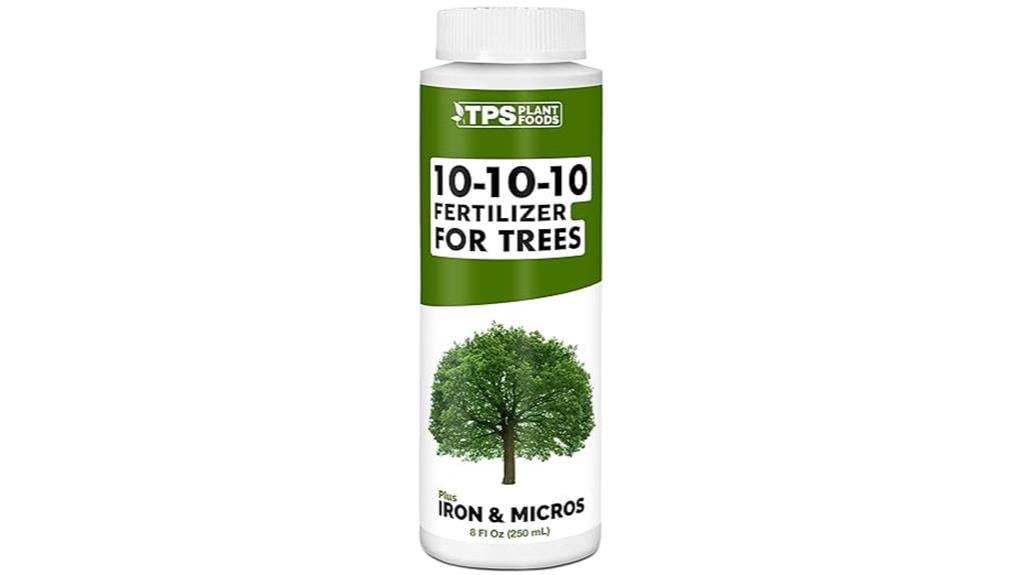
If you're looking to give your trees and shrubs the best start possible, the Liquid 10-10-10 Fertilizer is a fantastic choice. This professional-grade fertilizer features a balanced NPK ratio of 10-10-10, ensuring your plants receive essential nutrients. With 10% nitrogen, phosphorous, and potassium, it promotes healthy growth and robust development. I love that it's enriched with iron and micronutrients, catering specifically to the needs of trees and shrubs.
The liquid form allows for even distribution, making it easy for your plants to absorb all those crucial nutrients. Just be sure to follow the application instructions for maximum benefits. With the Liquid 10-10-10 Fertilizer, you can create a nutrient-rich environment that leads to bountiful harvests and vibrant greenery in your garden!
Best For: Home gardeners and landscapers looking to promote optimal growth and health in their trees and shrubs.
Pros:
- Balanced NPK ratio ensures essential nutrients are provided in equal measure for healthy plant development.
- Liquid form allows for easy application and efficient nutrient absorption.
- Enriched with iron and micronutrients, catering specifically to the needs of trees and shrubs for robust growth.
Cons:
- Requires careful adherence to application instructions to avoid over-fertilization.
- Limited quantity (8 oz) may not be sufficient for larger gardens or extensive landscaping projects.
- May not be suitable for all types of plants, as some may have different nutrient requirements.
SUPERthrive Plant Vitamin Solution and Jobe's Tree and Shrub Fertilizer Spikes
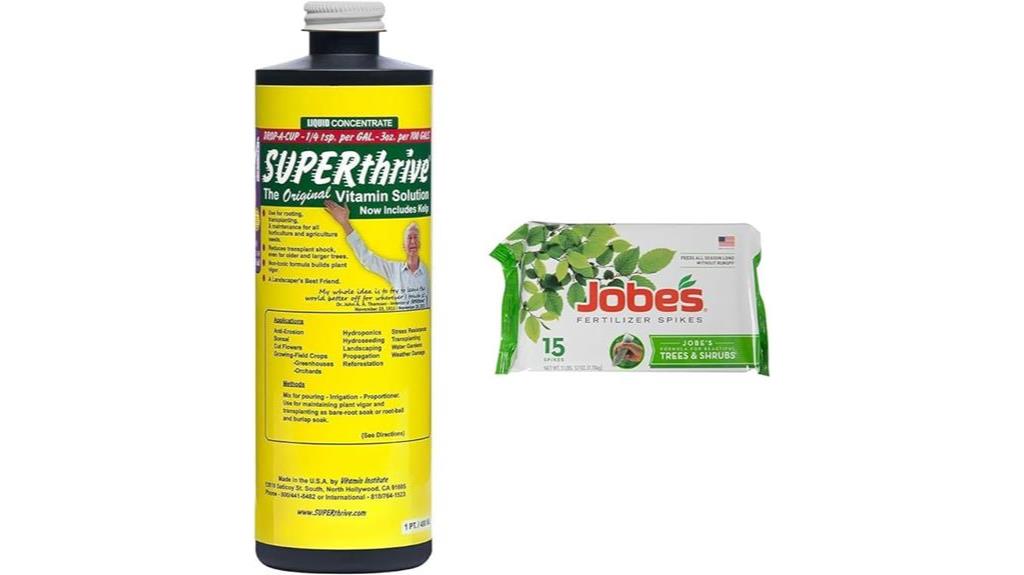
For gardeners looking to give their trees and shrubs a boost, both SUPERthrive Plant Vitamin Solution and Jobe's Tree and Shrub Fertilizer Spikes stand out as exceptional choices. SUPERthrive is a highly concentrated liquid, requiring just a drop per gallon for impressive results. I've seen my plants double in size and recover from near-death conditions in just a few weeks. It's particularly effective for addressing transplant shock. On the other hand, Jobe's slow-release spikes nourish the roots throughout the season, ensuring steady growth. While SUPERthrive can be a bit pricey, its long-lasting effectiveness makes it worth every penny. Together, these products have transformed my garden, making it healthier and more vibrant than ever.
Best For: Gardeners looking to enhance the growth and health of their plants, especially those dealing with transplant shock or seeking long-term nourishment for trees and shrubs.
Pros:
- Highly concentrated formula requires only a small amount for effective results, making it cost-effective.
- Positive user experiences report significant improvements in plant health and growth within a few weeks.
- Long-lasting effects of both products ensure sustained nourishment throughout the growing season.
Cons:
- Higher price point for SUPERthrive may deter budget-conscious gardeners.
- Application may require precision; too much of SUPERthrive can lead to ineffective results.
- Jobe's spikes may not provide immediate results compared to liquid fertilizers, requiring patience for visible effects.
Jobes 01310 Fertilizer Spikes, Tree and Shrub, 9 Count (Pack of 2)
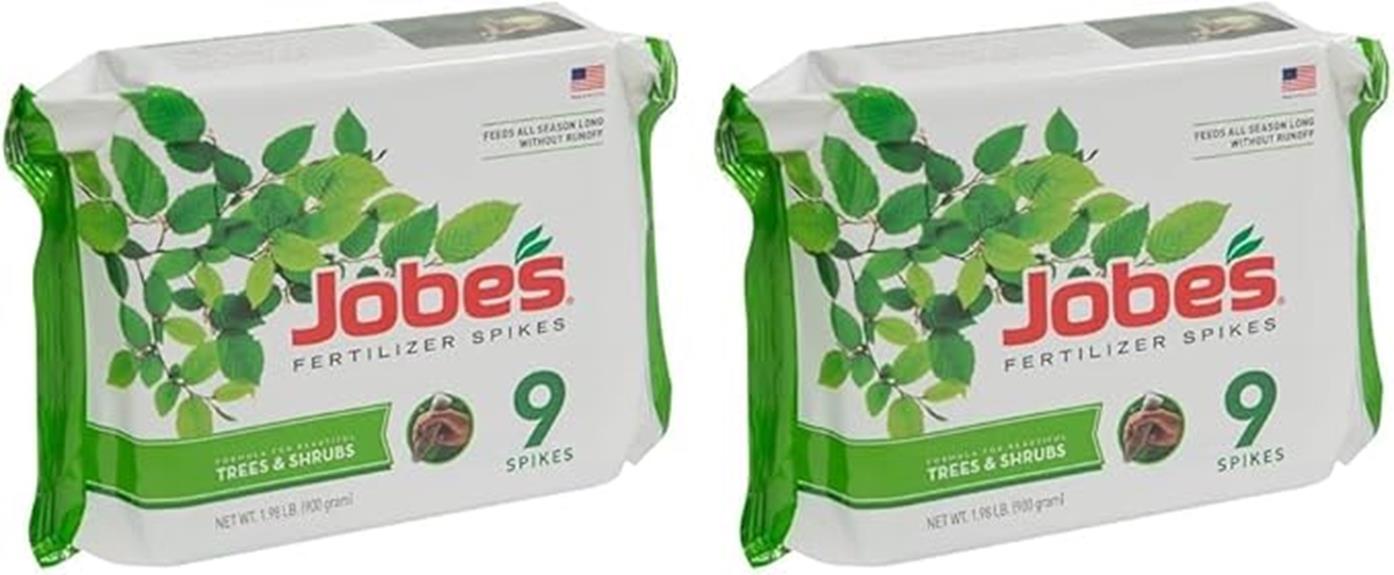
Jobes 01310 Fertilizer Spikes are the perfect choice for gardeners looking to simplify tree and shrub care. With their slow-release formula, these spikes provide essential nutrients directly to the roots, ensuring my plants thrive without any mess. Each pack contains 18 spikes, which is perfect for medium-sized gardens. I love how easy they are to use—just insert them around the plant's drip line, and I don't have to worry about measuring or mixing. Plus, they've received over 22,000 ratings with an impressive 4.6-star average, which speaks volumes about their effectiveness. I've noticed significant improvement in my trees and shrubs since using them. Just remember to water thoroughly after application for the best results!
Best For: Gardeners seeking an easy-to-use, effective solution for nourishing trees and shrubs.
Pros:
- Simple application process with no mixing or measuring required.
- Slow-release formula ensures nutrients are delivered steadily over time.
- High customer satisfaction with a 4.6-star rating from over 22,000 reviews.
Cons:
- Some users reported negative effects on specific tree species, like oaks.
- Insertion can be challenging in hard soil, leading to potential breakage of the spikes.
- Results may vary, with some users experiencing minimal impact on certain plants.
Jobe's Fertilizer Spikes for Trees & Shrubs (Includes 15 Spikes)
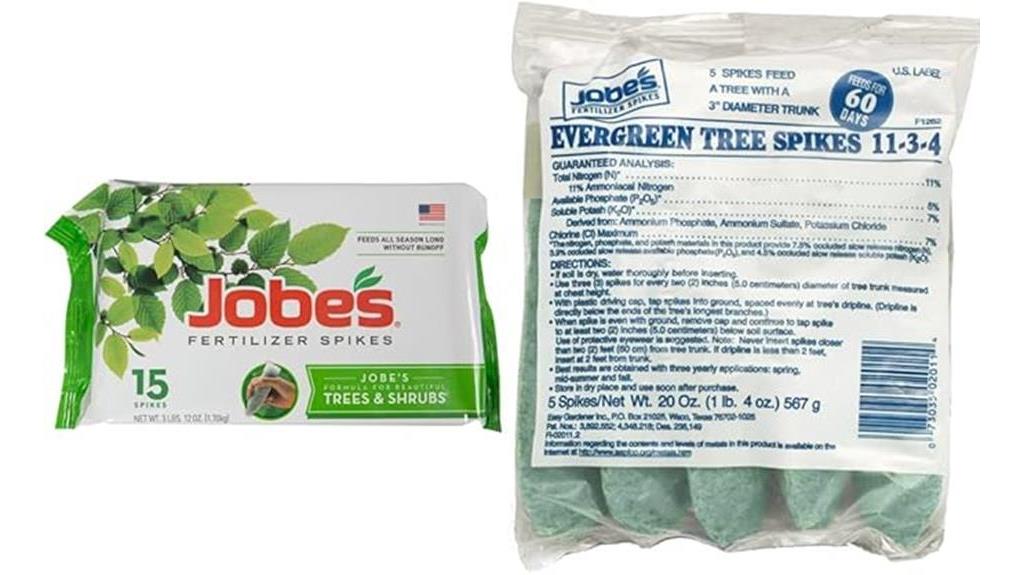
Looking for an effective way to nourish your trees and shrubs? I found Jobe's Fertilizer Spikes for Trees & Shrubs to be a fantastic option. Each pack includes 15 pre-measured spikes that deliver a slow-release formula, ensuring your plants receive a steady supply of nutrients all season long. I appreciate how easy they are to use; just insert them around your tree's dripline in early spring or late fall. Plus, there's no mess or harmful runoff, making it safer for my garden. Ideal for all deciduous trees and shrubs, these spikes even cater to acid-loving varieties. With a solid customer rating of 4.6 out of 5 stars, I'm confident they'll help your garden thrive!
Best For: Those looking for an easy and effective way to nourish deciduous trees and shrubs throughout the growing season.
Pros:
- Pre-measured spikes ensure accurate and mess-free application.
- Slow-release formula provides continuous nutrient supply for optimal plant health.
- Safe for the environment with no runoff or harmful odors, making it ideal for home gardens.
Cons:
- Limited to deciduous trees and shrubs, not suitable for all plant types.
- Requires specific application times (early spring and late fall), which may not suit all gardeners' schedules.
- Customer reviews indicate some users may desire a larger quantity per package.
Southern Ag All Purpose Granular Fertilizer & Jobe's Slow Release Tree and Shrub Fertilizer Spikes
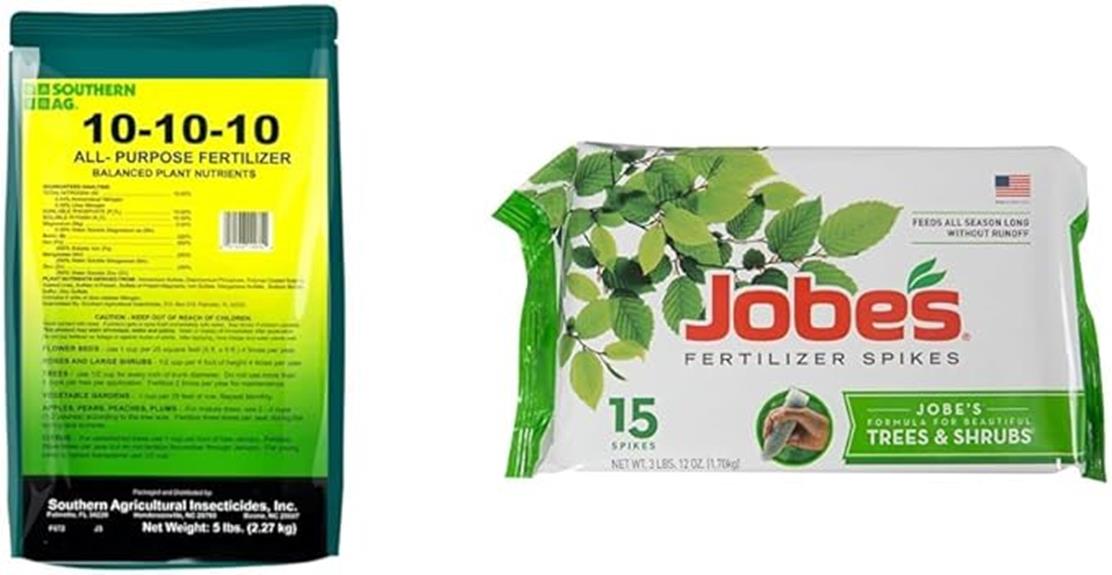
Southern Ag All Purpose Granular Fertilizer and Jobe's Slow Release Tree and Shrub Fertilizer Spikes stand out as top choices for anyone keen on nurturing a vibrant garden. The Southern Ag fertilizer, with its balanced 10-10-10 formula, covers 25 square feet per cup and is perfect for various plants, promoting root development and overall growth. It's highly rated by users, making it a reliable option. On the other hand, Jobe's spikes provide a slow-release nutrient supply, specifically designed for trees like oaks and maples. They're easy to use—just insert them around the tree's drip line—and require application only in spring and fall. Together, these products guarantee your garden thrives effortlessly throughout the year.
Best For: Gardeners looking for effective and easy-to-use fertilizers for a variety of plants, including trees and shrubs.
Pros:
- Versatile application: Suitable for various plants, enhancing root development and overall growth.
- Highly rated: Strong customer satisfaction with a 4.6 out of 5 stars rating from 2,240 users.
- Convenient use: Jobe's spikes allow for easy insertion and slow-release nutrients, minimizing mess and hazards.
Cons:
- Limited coverage: Southern Ag fertilizer has a specific coverage area, which may not be sufficient for larger gardens.
- Timing restrictions: Jobe's spikes must be applied only in early spring and late fall, which may not align with all gardening schedules.
- Availability concerns: Some users have reported issues with product availability and pricing fluctuations.
Factors to Consider When Choosing Tree and Shrub Fertilizers
When choosing tree and shrub fertilizers, you need to think about several key factors. Consider the nutrient composition and ratios that best suit your plants, as well as how easy the application method is for you. Don't forget to evaluate the type of fertilizer and its release rate to guarantee it meets the specific needs of your target species.
Nutrient Composition and Ratios
Understanding the nutrient composition and ratios of fertilizers is imperative for ensuring the healthy growth of trees and shrubs. The primary macronutrients in these fertilizers are nitrogen (N), phosphorus (P), and potassium (K), commonly referred to as the NPK ratio. This ratio markedly impacts plant health and growth, so choosing a balanced formula, like 10-10-10, can promote overall vitality, root development, and flowering.
Nitrogen supports leafy growth and overall vigor, making it essential for lush greenery. Phosphorus is crucial for root and flower development, while potassium aids in water regulation and enhances disease resistance. When selecting a fertilizer, consider the specific nutrient needs of your plants. Some trees and shrubs may require tailored compositions for ideal growth, so it's important to research the requirements of your particular species.
Additionally, don't overlook micronutrients like iron and trace elements, as these can address specific deficiencies and boost overall plant function. By understanding the nutrient composition and ratios, you can make informed choices that will lead to a thriving garden filled with healthy trees and shrubs.
Application Method and Ease
Choosing the right application method for your tree and shrub fertilizers can greatly influence how effectively your plants absorb nutrients. Liquid fertilizers, for instance, allow for even distribution and quick uptake, making them ideal when you need immediate results. On the other hand, fertilizer spikes offer a slow-release formula, ensuring a consistent supply of nutrients over time and reducing how often you need to apply them.
When selecting fertilizers, consider ease of use. Pre-measured spikes or granules simplify the process, eliminating the need for mixing or measuring, which is perfect whether you're a novice or a seasoned gardener. However, some fertilizers may require specific techniques or timing for best results. For example, applying spikes around the tree's drip line during the active growing season can maximize nutrient absorption.
Lastly, the physical form of the fertilizer matters. Liquid fertilizers are great for rapid absorption, while spikes provide a mess-free solution that minimizes runoff. By understanding these application methods, you can choose a fertilizer that not only meets your plants' needs but also fits your gardening style.
Type of Fertilizer
Selecting the right type of fertilizer is essential for ensuring your trees and shrubs thrive. You'll find fertilizers come in three main forms: liquid, granular, and spikes, each with unique advantages. Liquid fertilizers offer quick nutrient absorption, making them perfect for addressing immediate plant needs. They allow for even distribution, ensuring all parts of your plants benefit from the nutrients.
On the other hand, granular fertilizers, such as all-purpose options, typically release nutrients slowly over time. While they often require multiple applications throughout the growing season, this slow-release feature can provide steady nourishment. If you prefer to minimize waste and runoff, consider fertilizer spikes. These deliver nutrients directly to the root zone, ensuring your plants receive a continuous supply over an extended period.
When choosing a fertilizer type, think about your trees and shrubs' specific needs, how quickly you want nutrients delivered, and what's most convenient for you. Each form has its strengths, so weigh these factors carefully to make the best choice for your garden's success.
Target Plant Species
When it comes to fertilizing trees and shrubs, the specific species you're working with greatly influences your choice of fertilizer. Different species have varying nutrient requirements, so it's essential to select fertilizers tailored to their needs for best growth. For instance, deciduous trees and shrubs typically thrive on fertilizers with balanced NPK ratios, like 10-10-10, which supply equal amounts of nitrogen, phosphorus, and potassium to support overall health.
If you're dealing with acid-loving plants like azaleas and rhododendrons, look for fertilizers designed for their specific pH preferences. These formulations will cater to their unique growth conditions. Additionally, consider the growth stage of your plants. Whether they're newly planted, established, or recovering, each stage may need different nutrient compositions to thrive effectively.
Also, keep in mind that slow-release fertilizers can be particularly beneficial for certain tree and shrub types. They provide a steady supply of nutrients over time, promoting sustained growth while minimizing the risk of nutrient runoff. By understanding these factors, you'll be better equipped to choose the right fertilizer for your trees and shrubs.
Release Rate Variability
Understanding the various release rates of fertilizers is fundamental for effective tree and shrub care. You'll find two main types: slow-release and fast-release fertilizers. Slow-release formulas provide nutrients gradually, ensuring your plants receive consistent nourishment throughout their growing season. This method is especially beneficial during the active growth periods in spring and early fall.
On the other hand, fast-release fertilizers deliver nutrients quickly, but you'll likely need to apply them more frequently to maintain plant health. This can sometimes lead to nutrient runoff, which is a concern for the environment.
Soil conditions play a significant role in how fertilizers release their nutrients. For instance, higher temperatures and adequate moisture can accelerate nutrient availability, making it essential to take into account your local climate.
Lastly, understanding the specific nutrient needs of your trees and shrubs is critical. Some species may require an immediate nutrient boost, while others thrive with prolonged feeding. By evaluating the release rate that aligns with your plants' needs, you can make informed choices that promote healthy growth and longevity in your garden.
Environmental Impact Considerations
Choosing the right fertilizer for your trees and shrubs isn't just about boosting growth; it also involves considering the environmental impact of your decisions. Using slow-release fertilizers can greatly minimize nutrient runoff, reducing the risk of water pollution and supporting healthier ecosystems. This approach not only helps your plants thrive but also protects nearby water sources.
Opting for organic fertilizers often proves to be a more environmentally friendly choice. These options enhance soil health and biodiversity while cutting down chemical exposure. Additionally, fertilizers designed to deliver nutrients directly to the roots can improve uptake efficiency, decreasing waste and ensuring your plants get what they need without excess runoff.
It's also essential to choose fertilizers with balanced nutrient compositions. This prevents nutrient imbalances in the soil, which can harm both plant health and surrounding wildlife. Finally, utilizing biodegradable or natural fertilizer options contributes to sustainable gardening practices. These fertilizers decompose and enrich the soil without introducing harmful substances, allowing you to promote growth while being kind to the environment. When making your choice, consider how your fertilizer impacts not just your garden but also the broader ecosystem.
Frequency of Application
The frequency of application for tree and shrub fertilizers plays an essential role in achieving healthy growth and vibrant landscapes. Typically, the type of fertilizer you choose will dictate how often you should apply it. For granular fertilizers, aim for four applications per year. These provide a slow release of nutrients, which helps sustain your plants over time.
If you opt for slow-release fertilizers, you'll generally only need to apply them once or twice during the growing season. On the other hand, liquid fertilizers work quickly and might require monthly applications throughout the growing season to maximize their effectiveness.
It's vital to align your applications with the growth cycles of your trees and shrubs, so consider applying fertilizers in early spring and late fall when they are most active. Additionally, take into account the specific soil conditions and the health of your plants. If you notice any struggling plants, more frequent feeding can aid their recovery and growth, ensuring that your garden thrives. By adjusting the frequency based on these factors, you can provide your trees and shrubs with the nutrients they need to flourish.
Cost-Effectiveness and Value
When selecting tree and shrub fertilizers, cost-effectiveness and value can greatly influence your gardening success. Start by evaluating the nutrient concentration of different products; higher concentrations usually mean lower application rates and longer-lasting benefits. This can save you both time and money in the long run.
Consider the longevity of the fertilizer's effects as well. Slow-release formulas can provide nutrients over several months, reducing the need for frequent applications. This not only saves you money on purchasing more fertilizer but also minimizes the effort involved in reapplication.
To accurately compare value, calculate the price per application by dividing the total cost by the number of applications the product offers. You might find that a fertilizer with a higher upfront cost ultimately provides better value due to its effectiveness in enhancing plant health and growth.
Lastly, look for bulk purchasing options. Buying in larger quantities often leads to a lower price per unit, increasing your cost-effectiveness. By paying attention to these factors, you can guarantee that your investment in tree and shrub fertilizers pays off with healthier and more vibrant plants.
Frequently Asked Questions
How Often Should I Fertilize My Trees and Shrubs?
To keep your trees and shrubs healthy, you should fertilize them at least once a year, ideally in early spring. If you're using slow-release fertilizers, you might only need to apply them once a season. However, for more demanding plants, consider fertilizing again in late summer. Always check the specific needs of your plants, as some may require more frequent feeding. Remember, over-fertilizing can harm your plants, so balance is key!
Can I Use Tree Fertilizer on Other Plants?
Yes, you can use tree fertilizer on other plants, but it's important to be cautious. Tree fertilizers often have higher nitrogen levels, which can lead to over-fertilization in smaller plants or flowers. If you decide to use it, dilute the fertilizer or apply it sparingly. Always observe how the plants respond and adjust accordingly. Remember, not all fertilizers suit every plant, so it's best to know what specific nutrients your other plants need.
What Signs Indicate My Trees Need Fertilizer?
You'll know your trees need fertilizer if you spot signs like yellowing leaves, stunted growth, or sparse foliage. If your tree's bark is peeling or it's producing fewer flowers and fruits, that's another indicator. Pay attention to the soil as well; if it feels compacted or looks depleted, it might be time to feed your trees. Regularly checking these signs helps guarantee your trees stay healthy and thrive in your garden.
Are Organic Fertilizers Better Than Synthetic Options?
When you're nurturing your garden, think of organic fertilizers as a gentle breeze, nourishing your plants with natural goodness. They often improve soil health and encourage beneficial microorganisms, creating a vibrant ecosystem. Synthetic options, on the other hand, can be like a quick jolt of energy—effective but potentially harmful in the long run. Ultimately, it depends on your gardening goals; both have their merits, but organic usually fosters a healthier environment.
How Do I Apply Fertilizer Correctly to My Plants?
To apply fertilizer correctly, start by reading the instructions on the package. You'll want to determine the right amount for your plants based on their size and type. Spread the fertilizer evenly around the base, avoiding direct contact with the stems. Water the area afterward to help the nutrients soak into the soil. It's best to fertilize during the growing season, so your plants can absorb the nutrients effectively.
Wrapping Up
In nurturing your garden, think of fertilizers as the fuel for a race car. Just as a driver needs the right fuel to release their vehicle's potential, your trees and shrubs thrive with the proper nutrients. By choosing the right fertilizers like Liquid 10-10-10 or Jobe's Spikes, you're setting your plants up for a winning season. So, gear up and watch your garden zoom ahead, bursting with vibrant growth and health!
